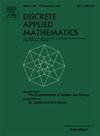Weakly toll convexity in graph products
IF 1
3区 数学
Q3 MATHEMATICS, APPLIED
引用次数: 0
Abstract
The exploration of weakly toll convexity is the focus of this investigation. A weakly toll walk is any walk between and such that is adjacent only to the vertex , which can appear more than once in the walk, and is adjacent only to the vertex , which can appear more than once in the walk. Through an examination of general graphs and an analysis of weakly toll intervals in both lexicographic and (generalized) corona product graphs, precise values of the weakly toll number for these product graphs are obtained. Notably, in both instances, the weakly toll number is constrained to either 2 or 3. Additionally, the determination of the weakly toll number for the Cartesian and the strong product graphs is established through previously established findings in toll convexity theory. Lastly for all graph products examined within our scope, the weakly toll hull number is consistently determined to be 2.
图积中的弱收费凸性
弱收费凸性的探索是本研究的重点。弱收费步行是在u和v之间的任意步行W:u,w1,…,wk−1,v,使得u仅与可在步行中出现不止一次的顶点w1相邻,并且v仅与可在步行中出现不止一次的顶点wk−1相邻。通过对一般图的检验和对字典图和(广义)电晕积图的弱收费区间的分析,得到了这些积图的弱收费数的精确值。值得注意的是,在这两种情况下,弱长途号码都被限制为2或3。此外,通过先前在收费凸性理论中建立的发现,建立了笛卡尔和强积图的弱收费数的确定。最后,对于我们范围内检查的所有图形产品,弱收费船体号始终确定为2。
本文章由计算机程序翻译,如有差异,请以英文原文为准。
求助全文
约1分钟内获得全文
求助全文
来源期刊

Discrete Applied Mathematics
数学-应用数学
CiteScore
2.30
自引率
9.10%
发文量
422
审稿时长
4.5 months
期刊介绍:
The aim of Discrete Applied Mathematics is to bring together research papers in different areas of algorithmic and applicable discrete mathematics as well as applications of combinatorial mathematics to informatics and various areas of science and technology. Contributions presented to the journal can be research papers, short notes, surveys, and possibly research problems. The "Communications" section will be devoted to the fastest possible publication of recent research results that are checked and recommended for publication by a member of the Editorial Board. The journal will also publish a limited number of book announcements as well as proceedings of conferences. These proceedings will be fully refereed and adhere to the normal standards of the journal.
Potential authors are advised to view the journal and the open calls-for-papers of special issues before submitting their manuscripts. Only high-quality, original work that is within the scope of the journal or the targeted special issue will be considered.
 求助内容:
求助内容: 应助结果提醒方式:
应助结果提醒方式:


